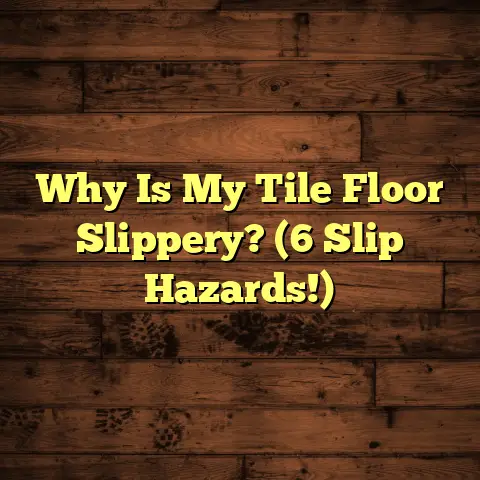Stop Basement Floor Squeaks? (3 Quick Fixes!)
Imagine your basement floor is like an old, creaky ship, sailing through the rough seas of humidity and temperature changes.
Every groan and squeak is like a distress signal, telling you something isn’t quite right below deck.
Just like a ship needs maintenance, your basement floor does too. Those squeaks aren’t just annoying; they can indicate deeper problems.
Let’s batten down the hatches and get those squeaks silenced, creating a smoother, more stable home environment.
Understanding the Cause of Squeaks
As a flooring contractor with years of experience, I’ve seen my fair share of squeaky floors.
And believe me, they’re not all created equal.
The most common culprits in basements?
-
Humidity: Basements are notorious for moisture. Wood expands and contracts with humidity changes, causing friction.
-
Temperature Swings: Similar to humidity, temperature fluctuations can wreak havoc on wood flooring.
-
Settling Foundations: Over time, your house settles. This can put stress on the floor joists, leading to movement and, you guessed it, squeaks.
-
Friction: At the heart of most squeaks is friction. When floorboards rub against each other, or against the joists underneath, you get that telltale sound.
Think of it like rubbing two pieces of wood together. That’s essentially what’s happening under your feet.
Before grabbing your tools, the key is to pinpoint the source of the squeak. Is it one specific spot, or is it widespread?
This will help you determine the best course of action.
Quick Fix #1: Shimming the Joists
One of the most effective ways to stop those pesky squeaks is by shimming the joists.
What exactly does that mean?
Well, over time, gaps can develop between the floorboards and the joists underneath. Shimming involves inserting thin pieces of material (shims) into these gaps to create a snug fit, eliminating movement and friction.
Here’s how I usually tackle this:
-
Locate the Squeak: Walk around the area, paying close attention to where the squeak is loudest. Once you’ve identified the spot, try to determine which joist is underneath it.
-
Access the Joists: This might involve removing some of the finished ceiling in your basement, or working from below if you have an unfinished basement. Safety first! Wear eye protection and a dust mask.
-
Identify the Gap: Look for the gap between the floorboard and the joist. You might need a flashlight to get a good view.
-
Choose Your Shims: You can use wood shims, plastic shims, or even pieces of cardboard in a pinch. I prefer wood shims because they’re strong and can be easily cut to size.
-
Insert the Shim: Gently tap the shim into the gap using a hammer. You want a snug fit, but don’t force it. You don’t want to lift the floorboard.
-
Secure the Shim: Once the shim is in place, you can secure it with construction adhesive or a couple of small nails.
Pro Tip: I often use a “shim sandwich” – two thin shims placed on top of each other, allowing for even finer adjustments.
Material Matters: For wood shims, I recommend using a hardwood like oak or maple. They’re less likely to compress over time than softwood.
Securing the Shims: Construction adhesive is your best friend here. It’ll keep those shims in place for years to come.
Quick Fix #2: Applying Lubricants
Sometimes, the squeak isn’t due to a large gap, but rather to the friction between two tightly fitted floorboards. In these cases, a lubricant can work wonders.
Think of it like oiling a squeaky door hinge.
The principle is the same: reduce friction and silence the noise.
Here’s my rundown of lubricant options:
-
Graphite Powder: A classic choice. Graphite is a dry lubricant that won’t attract dust or dirt. It’s great for tight spaces.
-
Talcum Powder: Similar to graphite, talcum powder is a dry lubricant that can be used in small amounts. Be careful not to use too much, as it can become cakey over time.
-
Silicone Spray: A synthetic lubricant that’s water-resistant and long-lasting. It’s a good option for basements with high humidity.
-
Floor Squeak Lubricant: There are several specialized lubricants designed specifically for squeaky floors. These often come in a squeeze bottle with a narrow nozzle for easy application.
Eco-Friendly Options: If you’re concerned about using harsh chemicals, consider beeswax or a natural oil-based lubricant.
Application Techniques:
-
Identify the Source: Again, pinpoint the exact location of the squeak.
-
Prepare the Area: Clean the area around the squeak with a damp cloth.
-
Apply the Lubricant: Use a squeeze bottle, a small brush, or a nozzle attachment to apply the lubricant directly into the gap between the floorboards.
-
Work it In: Walk over the area to work the lubricant into the gap.
-
Wipe Away Excess: Wipe away any excess lubricant with a clean cloth.
Reaching Tight Spaces: For hard-to-reach areas, I use a small artist’s brush or a syringe to apply the lubricant.
Even Distribution: Don’t overdo it! A little lubricant goes a long way. Apply a small amount and then walk over the area to distribute it evenly.
Quick Fix #3: Screwing Down the Floorboards
Sometimes, nails just aren’t enough. Over time, they can loosen, allowing the floorboards to move and squeak.
The solution? Replace those nails with screws.
Screws provide a much tighter grip, holding the floorboards securely to the joists.
Here’s how I do it:
-
Locate the Squeak: You know the drill (pun intended!). Find the exact spot where the floor is squeaking.
-
Find the Joist: Use a stud finder to locate the joist underneath the floorboard.
-
Drill Pilot Holes: This is crucial! Drilling pilot holes prevents the wood from splitting. Use a drill bit that’s slightly smaller than the diameter of the screws.
-
Drive in the Screws: Use a drill or screwdriver to drive the screws into the floorboard and the joist. Make sure the screw heads are flush with the surface of the floor.
-
Repeat as Needed: Add more screws along the joist to secure the floorboard.
Screw Spacing: I generally recommend spacing screws every 6-8 inches along the joist.
Choosing the Right Screws:
-
Length: The screws should be long enough to penetrate at least 1 inch into the joist.
-
Type: Use wood screws designed for flooring. These have a flat head that sits flush with the surface of the floor.
-
Material: I prefer using stainless steel screws in basements because they’re resistant to rust and corrosion.
Avoiding Damage: Be careful not to overtighten the screws. This can strip the wood and weaken the connection.
Long-Term Repair: Screwing down the floorboards is a more permanent solution than shimming or lubricating. It provides a strong, secure connection that will last for years to come.
Conclusion
Basement floor squeaks can be a real nuisance, but they don’t have to be a permanent fixture in your home. By understanding the causes of these squeaks and applying one or more of these quick fixes, you can enjoy a quieter, more stable living space.
Don’t ignore those squeaks! Addressing them promptly can prevent further issues down the road.
So, grab your tools, assess your basement, and get ready to silence those squeaks once and for all! Your ears (and your sanity) will thank you.





